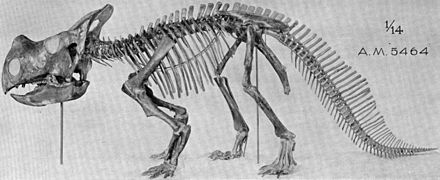Montanoceratops
Montanoceratops /mɒnˌtænoʊˈsɛrətɒps/ is an extinct genus of small ceratopsian dinosaur that lived approximately 70 million years ago during the latter part of the Cretaceous Period in what is now Montana and Alberta. Montanoceratops was a small sized, moderately-built, ground-dwelling, quadrupedal herbivore, that could grow up to an estimated 3 m (9.8 ft) long.
Montanoceratops was a typical primitive ceratopsian in many respects, distinguished from the later species by the presence of claws, rather than hooves, and by having teeth in its upper jaw, rather than a toothless beak. It was once thought to have a horn on its nose but that was a misplaced cheek horn.[1]
According to Brown and Schlaikjer (1935), Montanoceratops can be distinguished based on the following characteristics:
The first fossil remains of what we now know as Montanoceratops were discovered on the Blackfeet Indian Reservation, west of Buffalo Lake, Montana in the St. Mary River Formation. It was collected in 1916 by Barnum Brown and Peter C. Kaisen of the American Museum of Natural History from terrestrial sediments that were deposited during the Maastrichtian stages of the Cretaceous period, approximately 70 million years ago. After having mounted a reconstruction in 1935, Brown and his assistant Erich Maren Schlaikjer named it in 1942 as a new species of Leptoceratops: Leptoceratops cerorhynchos; this is the type species of Montanoceratops. The genus name Montanoceratops, means "Montana horned face", and is derived from the state of Montana, which is the site of the discovery of the holotype specimen, and the Greek words "keras" (κερας) meaning "horn", and "ops" (ωψ) meaning "face".[2] The type and only valid species known today is Montanoceratops cerorhynchos.
The original type material discovered by Barnum Brown, designated specimen AMNH 5464, included an incomplete skull and mandible (with most of the skull absent), a complete series of eleven cervical, twelve dorsal and eight sacral vertebrae, thirteen complete caudal vertebrae and the centra of two others, several ribs, a complete pelvic girdle except for the right pubis and the distal part of the right ischium, both femora (346mm), the left tibia (355mm), left fibula and left astragalus, the second phalanx of digit three, and the ungual phalanges of the first, third and fourth digits of the left pes (foot).[3] This specimen is housed in the collection of the American Museum of Natural History in New York City, USA.
In 1986, David B. Weishampel discovered more material referable to Montanoceratops in the Little Rocky Coulee locality of the St. Mary River Formation, in Glacier County, Montana. The material, which was found in terrestrial sediments, was also considered Maastrichtian in age. A description of this material was published in a paper by Brenda Chinnery and Weishampel in 1998.[4] In 2001, Peter Makovicky examined and described specimen AMNH 5244, an incomplete but well-preserved braincase that he assigned to Montanoceratops. This specimen was collected by Barnum Brown in 1910, from terrestrial sediments on the east bank of the Red Deer River near Tolman Ferry at the Horseshoe Canyon Formation in Alberta, Canada.[5] This specimen is also housed in the collection of the American Museum of Natural History.



